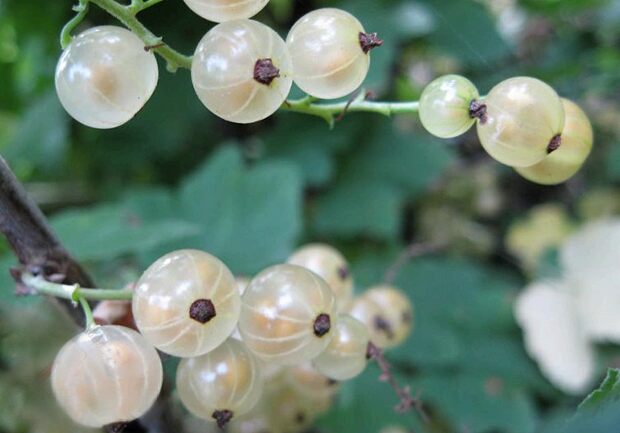Nature generously presented currants, decorating not only black and red berries, but also white ones, awarding each variety with characteristic qualities. White currant bushes enrich the gardens, and fruits are considered to be healing berries.
Table of contents
Description and characteristics of white currant
Currant's homeland is Europe and Russia, where approximately in the tenth century the bushes met with red berries. White currant appeared some time later, as a result of the “domestication” of red berry culture.
The plant belongs to the Kryzhovnikov family.It is a perennial shrub with a height of one and a half meters. But in a climate that is ideal for a plant, a bush can reach two meters.
The bush is decorated with 3-5 lobed dense leaves, the edges of which are jagged. Small, inconspicuous flowers, yellow-green, collected in a brush, bloom in May.
Juicy, tasty fruits have a yellow, cream or light pink color, spherical shape, with a diameter of 6-10 mm. The ripening period falls on July, August.
The plant has a number of advantages:
- when complying with agrotechnics, the plant gives annual abundant crops and is well suited for reproduction;
- the berries are on the bushes for a long time and do not crumble until late autumn;
- not susceptibility to currant mite, which is the main enemy of the shrub;
- actively fruiting in both arid and rainy weather conditions, thanks to a strong and highly developed root system;
- frost resistance, therefore, will delight with tasty fruits regardless of the weather;
- is an unpretentious berry, therefore, requires minimal care;
- fruits of universal appointment with a high assessment of tastes and good transportability.
In addition to the weighty advantages of culture, there are minor flaws, namely:
- with improper formation of the bush late comes into fruiting;
- in shady places it grows poorly, bears little fruit and is more damaged by diseases and pests.
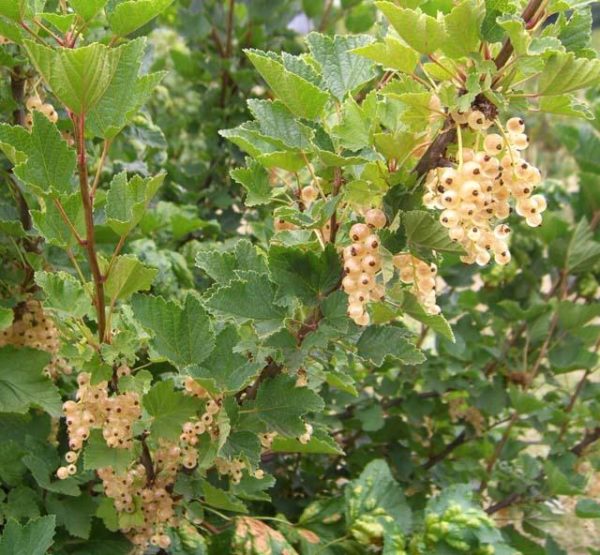
Health benefits and harm
In addition to the delicate and unique taste of white currant is considered a source of nutrients, a mine of vitamins and minerals.
Possessing a number of useful properties, it has a positive effect on almost the entire human body because:
- provides full operation of the heart and blood vessels;
- normalizes redox processes, increases immunity and protects the body against viral diseases;
- stimulates the separation of bile, helps strengthen the liver cells;
- absorbs and removes from the body salts of heavy metals;
- helps get rid of excess cholesterol;
- is a good antipyretic agent;
- prevents memory loss and the development of sclerosis in the elderly;
- rejuvenates the body and slows the aging process;
- promotes mental and physical activity of the body.
But no matter how useful a berry may be, there is a category of people who should refrain from using it in order not to harm their body. This group includes patients suffering from gastritis, with increased acidity and a tendency to ulcers.
Since the composition of the berries is rich in organic acids, which can provoke exacerbations of these diseases. Also, you should not get involved in the fruits of thrombophlebitis, since due to the high content of vitamin K can increase blood clotting.
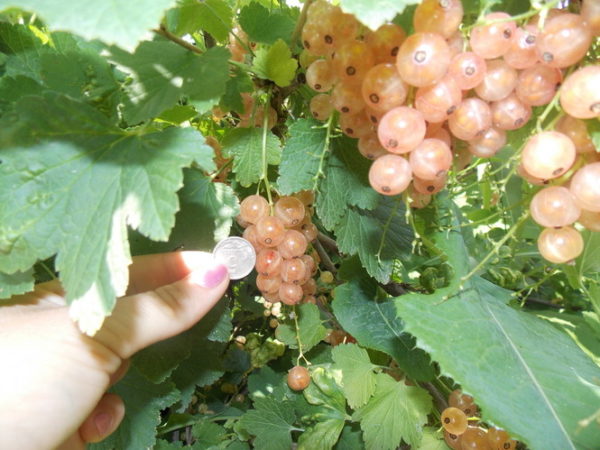
Curative berry is a supplier of nutrients in the body, which has a positive effect on human health. The main thing to remember about contraindications, which will remove the maximum benefit from the product while not harming health.
Planting and growing rules in autumn and spring
The plant is best planted in the fall. Begin the event in the second half of September and until the end of October. The main thing is not to miss the deadlines so that young saplings have time to get rooted in the soil and adapt to external conditions. You can also plant in the spring, but you need to land as soon as possible, as soon as the ground allows, and until the buds have blossomed at the seedling.
- Determining the landing site
Currants are demanding for location, humidity and heat, because they do not tolerate a damp, marshy and very shaded place. Best of all, the culture will bear fruit on a sunny, windless stretch. Given this, seedlings should be planted on the south or southwest side. Planting should be carried out on clayey, loamy and sandy soils. In addition, the level of groundwater distribution should be taken into account. And if their depth exceeds the permissible norm, then it is imperative to plant on the bulk mounds. Excessive moisture can cause lichen and plant death.
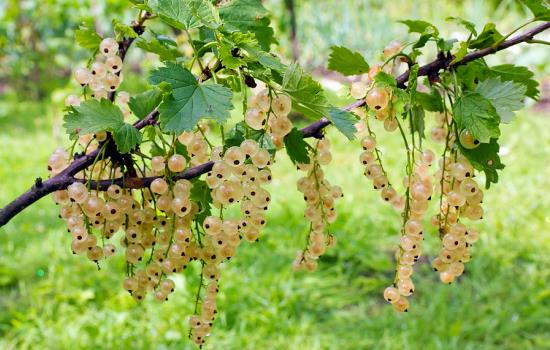
- Technology of preparation of the pit for planting seedlings
Before a few weeks, you need to dig a plot, clean it from weeds and apply fertilizer using compost and wood ash. Under the shrubs to dig holes with a diameter of 50 cm and a depth of 40 cm. The distance from one bush to another must be at least one meter. Equip the bottom of the pit with humus mixed with the ground. If the soil is highly acidic, you must add lime.
- Landing process
High-quality planting material is the determining factor when laying currants, as weak and diseased seedlings will not give the opportunity to grow from them full-fledged, prolific berry bushes. A good seedling should have three large roots, about 15 cm long. The aerial part should have at least two branches about 40 cm long.
Carefully place the seedling at a 45̊ angle in the planting hole, if possible with a slope to the north, so that the root grows to the south. Lower by fifteen centimeters so that the plant could better develop additional roots and quickly began to grow. Then gently straighten the rhizomes, and fill them with fertile soil.
- Necessary activities after landing
Upon completion of the work, the earth around the bush should be gently compacted, well watered and mulched with humus. Also, the shoots of the seedling pruned and leave only two buds above the ground. This procedure will promote the development of a healthy root system, the formation of a well-branched shrub and the establishment of a strong and healthy culture.
Care and breeding tips
Care is the implementation of appropriate procedures that will help increase the yield and improve the quality of the berries. These activities include:
- Watering. The white currant loves water very much, therefore it is necessary to water it often, especially in arid time. To reduce the loss of moisture, it is recommended to mulch the ground around the shrub. The most regular watering necessary for the plant in the period of the onset of the appearance of berries and their ripening. In order for weeds not to take away moisture, nutrients and sunlight from a plant, it is necessary to eliminate them in a timely manner.
- Trimming and shaping. In order for the bushes to be strong and fruitful, they should be pruned in a timely and correct manner. The first time pruning is carried out after the landing. Remove all branches, while leaving three buds at the base of the shoot. This will help the plant to direct all its forces to the growth of the roots, which will subsequently enable the plant to release strong fruitful shoots in the spring.
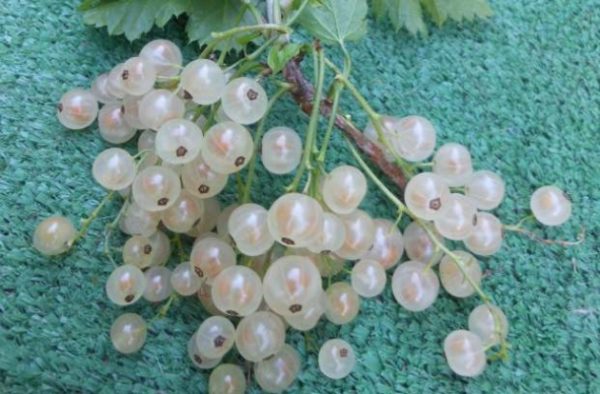
Formative pruning to perform every fall, while leaving about three strong shoots. The rest of the shoots cut at the base.
- Top dressing. The plant is responsive to good nutrition, which is used as potash, nitrogen, organic and phosphorus additives. After each application of fertilizer, you need to mulch the earth with a mixture of peat and manure. This will help to better absorb fertilizers, as well as protect the berry crop from weed growth and retain moisture. Will be useful and foliar feeding solutions of potassium permanganate or boric acid. These spraying will increase the size of the fruit and increase its setting.
Timely implementation of these procedures will favorably affect the quality of the harvest and the development of the bush as a whole.
The most famous varieties
Ural white
Ural white variety mid-early gestation period. A densely growing bush has a moderate height. Slightly curved shoots of medium thickness, have a greenish color with the presence of a pinkish pale patina. Large, five-lobed leaves have a green color with sharp long teeth. Flowers of medium size, sepals yellow-green, bent. Rounded berries yellow color, endowed with seeds in small quantities. Fruits of universal appointment of a pleasant sweet taste and slightly noticeable sourness.
White fairy
White fairy - mid-season variety, self-pollinating. Productivity is high. Medium-sized shrub is formed very thick and lush. Brushes are thin, long. The berries are round, one-dimensional, weighing from 0.6 to 0.8 grams. The color of the fruit is white, with a yellowing. Differ, thin, but dense skin. Gentle sweet-sour taste, without aroma.
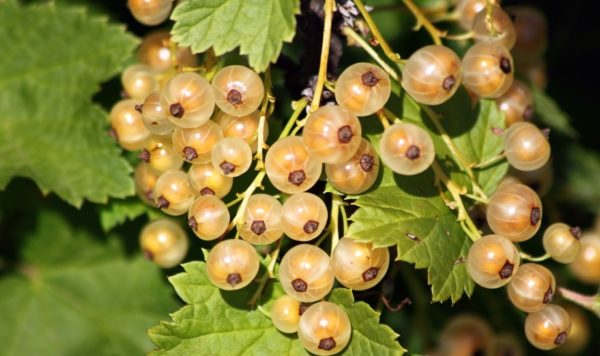
Dessert Bayana
Dessert Bayana - universal variety of late ripening period.It is one of the best white beauty varieties in terms of yield, fruit quality and disease resistance. Shrub medium size, but very thick. Leaf 3-5 lobes, large, light green, dull, slightly pubescent from below, elongated. The berries are white in color, round, transparent. Juicy fruits with a pleasant sweet-sour taste and thin skin.
White currant is one of the most unpretentious plants in the garden. Important are its taste properties, which are characterized by the content of many useful substances, so the culture enjoys special demand and great popularity.
